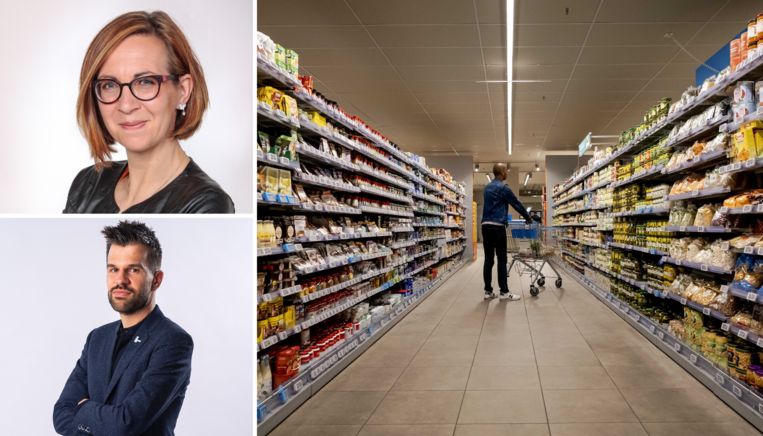Supermarket prices are stabilizing. This month, about as many products on the shelves became cheaper as prices rose, according to the latest consumer price index released today. ‘And then July isn’t even a promotion month.’ Which items became cheaper? Which more expensive? And is the peak of price increases really behind us?
Sven Ponsaerts 29 July 2023, 15:00
Danone derives more turnover from lower sales. Coca-Cola benefits from price increases. Despite billions in profit, Unilever expects even more price increases. It was only a few articles in the newspaper this week that once again reminded us of the more expensive shopping cart. Compared to a year ago, our food and (non-alcoholic) drinks are now 13.86 percent more expensive, according to the new consumer price index that Statbel announced today. Knowing that food inflation was still flirting with 20 percent a few months ago is somewhat reassuring.
“The peak in food inflation was already reached in May, and is therefore behind us,” says Professor of Economics and member of the index committee Stijn Baert (UGent). “The price difference was the greatest then compared to a year earlier. In the meantime, that gap is getting smaller.” Although, according to Baert, this is mainly because food prices were rising sharply at this time last year. “So we compare with increasingly expensive months.”
We still paid 0.52 percent more for food and drink this month than in June. “We are at a plateau,” concludes Baert. But the turnaround has begun. In any case, the biggest price increases are behind us, according to observers. The long-awaited tipping point, where there are no longer more products rising in price than keeping their price or becoming (slightly) cheaper, came this month. Of the approximately 65 different product groups of which Stabel monitors the price evolution every month, about half fell in price, the other half continued to rise. Usually it wasn’t about big jumps, regardless of direction.
The prices of eggs and butter, but also of coffee, tea, pork and poultry, among other things, fell slightly again for the first time in a long time. Professor Els Breugelmans, Professor of Marketing at KU Leuven, sees this as the first signs that the supermarket bill will no longer rise sharply. “Unprocessed products such as eggs and butter, which are very close to the real raw materials, are typically the first to drop in price. For processed products, in which energy and raw materials from a few months ago were put in, any price adjustment usually follows with a delay.”
Breugelmans points out that due to current contracts between producers and department stores, the fall in international raw material prices is only being passed on in a limited number of products. “The drop we are seeing now is likely to be even stronger once the negotiations are completed in the autumn or January. Also know that in a holiday month like July there are traditionally fewer promotions that push the price down even further.”
Stijn Baert qualifies somewhat: “The new general inflation rate of 4.14 percent is still very close to last month’s 4.15 percent. The increase in the general cost of living compared to a year ago therefore did not decrease any further, while the Planning Bureau expected inflation to amount to 3.71 percent in July. So it is a bit like with the corona curves at the time: we would expect to fall further, but we have reached a plateau for a while.”
Especially unhealthy products cheaper
Spirits generally became more than 8 percent cheaper. Tea, fruit juice and coffee, among other things, also became slightly cheaper, as did ice cream, crisps, beer and breakfast cereals. It is therefore not immediately the healthiest products in the supermarket that fell in price this month. Although a very small price decrease for fruit (-1.29 percent) has also been recorded.
Naturally, not all products were spared a price increase. Rice and olive oil, for example, became about 4 percent more expensive. However, the biggest upward price jumps were for potatoes, which became almost 15 percent more expensive, and fresh seafood (+18 percent). According to the experts, such outliers in agricultural and fishery products are probably related to harvest conditions and the aspect of supply and demand. “In July, with this weather, the Belgian likes to put his feet under the table for a portion of shrimps,” says Baert. “If the catch does not increase accordingly, you can expect such price increases.” Potato cultivation, on the other hand, suffered from last year’s dry summer. “Seasonal influences mean that the price of fruit and vegetables is very volatile anyway,” adds Breugelmans.
Should we really expect a drop in prices in the supermarket? Isn’t stabilization a more realistic scenario for many products? Breugelmans: “We know from the past that price increases are certainly not followed by equally large decreases. Consumers get used to these higher prices, which then become the new normal. Well, this is an exceptional period, so it remains to be seen to what extent a possible downward correction will follow. But the fall will never be as spectacular as the rise was anyway.”
Read also
2023-07-29 13:00:02
#supermarket #prices #stabilizing #products #expensive #cheaper


